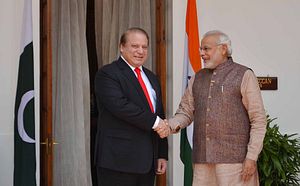The success rate of confidence-building measures (CBMs) between India and Pakistan has remained unimpressive so far, especially in terms of creating an enabling environment for conflict resolution. The bilateral dialogue has been in a stalemate for about a decade, primarily because of the shifting strategic environment in the region. To overcome the obstructions caused by an inimical strategic environment for peace negotiations, broader agreement on the vision for these efforts is required between different stakeholders within India and Pakistan. Without this, the peace talks and CBMs are in danger of being a will-o’-the-wisp.
Whether the past will remain a prologue for South Asian peace negotiations remains to be seen, but it inevitably provides invaluable lessons which can help to chalk out a different future. The Lahore Declaration and the Composite Dialogue created a lot of hope for the peaceful settlement of disputes. However, the strategic environment shifted in the decade after, and this had a strong impact on the occurrence, nature, and result of negotiations between India and Pakistan.
In 1998, overt nuclearization brought a certain balance between the two states, as well as urgency to military and political issues in the face of inherent risk of escalation. The introduction of nuclear weapons underscored the fact that a military solution to the neighbors’ problems was not really possible. Prevention of escalation in Kargil proved exactly the same. Though the Lahore process was initially thought to be a casualty of Kargil, the recently-achieved ‘balance of terror’ enabled substantive ground to be covered by the two sides during the composite dialogue.
By 2006-07, this scenario began to change due to India and Pakistan’s different trajectories of economic development and military modernization. This phenomenon was exacerbated by the U.S. policy of dehyphenation that envisioned India as a possible counterweight to China in the Indian Ocean region. This inflated India’s self-image, resulting in New Delhi not treating Islamabad equally. Emphasizing the issue of terrorist groups allegedly getting support from Pakistani territory over a discussion on Kashmir, or the possibly Indian-linked effects of transnational terrorism faced by Pakistanis are examples of Indian heavy-handedness. Today, the strategic balance tilts towards India, which encourages it to deal with Pakistan asymmetrically in military and political terms. Ostensibly, the so-called dividend for peace has reduced for India. Its self-perception as a great power also led India to formulate an impractical military solution to the issue of non-state actors and terrorism, known as Cold Start, which only increases Pakistani reliance on nuclear deterrence.
A decade of internal instability has worn down Pakistan’s economic and security structures. Thus, a positive turn in relations with India is in its immediate interest. However, it would still be unreasonable to expect Pakistan to make fundamental concessions on Kashmir or bring it down the priority list of issues to be discussed, due to historical baggage as well as strategic and ideological linkages. The interplay of asymmetry in relations has led to the current stalemate between New Delhi and Islamabad.
The past ten years of Indo-Pakistan peace talks have not produced any profound results. Just as Kargil derailed the peace process due to a lack of consensus within Pakistan in 1999, the current contradiction within Indian policy of both negotiating with Pakistan and undermining conventional deterrence is unhelpful. It is crucial to develop internal consensus within both countries on what a prospective peace process should entail. An open, internal dialogue would, in fact, be the most profound CBM that India and Pakistan can undertake. Such internal consensus-building is underway in some measure in Pakistan. A paradigm shift on the thinking about terrorism began to emerge by the end of General Kayani’s tenureand was further shaped under General Sharif. The recurring terrorist incidents and ensuing military operations have led to a comparably more open and comprehensive national discussion on the issue of terrorism and expanding operations to urban centers. Structural changes like these would enhance Indian confidence more than any number of promises, CBMs, or creation of joint investigation teams.
However, the Modi government’s policy towards Pakistan is marred by contradictions. Instead, the Indian leadership should begin internal dialogue on the nature of the Kashmir issue and why an immediate resolution is in India’s interest, instead of falling back on mounting pressure from different quarters within India to cancel talks. This will increase Pakistan’s confidence in India’s sincerity to pursue negotiations. Furthermore, the military’s doctrinal and capability modernization should be with the strategic utility and political goal of establishing peaceful relations with Pakistan. At this juncture, India’s opposition to the meeting between Hurriyat leaders and Pakistani interlocutors is seen more as a pressure tactic aimed at gaining unfair advantage, since the existing sentiment in Pakistan seems to be to work on peaceful relations with India.
Toby Dalton argues that incrementalism as an approach toward the Indo-Pak peace dialogue has not produced results, and therefore, a new approach is needed. However, no amount of high-profile political gesturing or government support of the process will make peace talks sustainable, unless all stakeholders to the conflict within India and Pakistan are onboard. What made the composite dialogue process unique was not just the political and symbolic gesturing and risk-taking of the decision-making elite, but that there was consensus among major stake holders within each country to pursue peace. Thus, wider internal discussion on Kashmir and terrorism will be a helpful parallel process, and could be pursued as an extension of the CBM process between India and Pakistan.
Sobia Paracha is a resident consultant at the Islamabad Policy Research Institute. A version of this piece originally appeared at South Asian Voices, an online platform for strategic analysis and debate hosted by the Stimson Center.

































